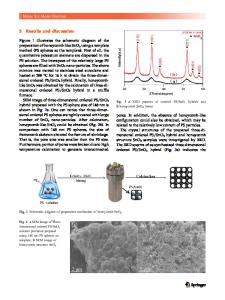Investigation into Microwave Absorption in Semiconductors for Frequency-Multiplication Devices and Radiation-Output Cont
- PDF / 519,874 Bytes
- 6 Pages / 612 x 792 pts (letter) Page_size
- 15 Downloads / 314 Views
INTERNATIONAL SYMPOSIUM “NANOPHYSICS AND NANOELECTRONICS”, NIZHNY NOVGOROD, MARCH 10–13, 2020
Investigation into Microwave Absorption in Semiconductors for Frequency-Multiplication Devices and Radiation-Output Control of Continuous and Pulsed Gyrotrons K. V. Maremyanina, V. V. Parshinb, E. A. Serovb, V. V. Rumyantseva,*, K. E. Kudryavtseva, A. A. Dubinova, A. P. Fokinb, S. S. Morosovc, V. Ya. Aleshkina, M. Yu. Glyavinb, G. G. Denisovb, and S. V. Morozova a Institute b
for Physics of Microstructures, Russian Academy of Sciences, Nizhny Novgorod, 603950 Russia Institute of Applied Physics, Russian Academy of Sciences, Nizhny Novgorod, 603950 Russia c Lobachevsky State University of Nizhny Novgorod, Nizhny Novgorod, 603950 Russia *e-mail: [email protected] Received April 15, 2020; revised April 21, 2020; accepted April 21, 2020
Abstract—The results of experimental investigation into the dielectric losses in GaAs, InP:Fe, and Si semiconductor crystals in the millimeter wavelength range (80–260 GHz) using the original precise method of measuring the reflectance and dielectric-loss tangent tanδ based on open high-quality Fabry–Perot cavities are presented. It is shown that the losses in the frequency range from 100 to 260 GHz in ultrapure semiconductor single-crystal GaAs substrates are mainly determined by lattice absorption, while the main loss mechanism in single-crystal silicon is absorption by free carriers; herewith, tanδ ≈ (1–2) × 10–4 even for a noticeable, at a level of 1012 cm–3, free carrier concentration. In contrast with GaAs and Si, tanδ in compensated InP:Fe crystals is almost independent of frequency in the range from 100 to 260 GHz, which is associated with the material conductivity and optimization of microwave semiconductor devices, in particular, frequency-multiplication devices and devices of the controlled emission output of continuous and pulsed gyrotrons. Keywords: subterahertz range, GaAs, InP:Fe, Si, absorption, dielectric-loss tangent DOI: 10.1134/S1063782620090195
1. INTRODUCTION High-power sources of coherent radiation of the far infrared (FIR) and terahertz (THz) ranges are in practical demand to solve many problems of a fundamental and applied character such as the development of new spectroscopy methods for semiconductor structures and biological objects [1], control over chemical reactions [2], manipulation by electron states in quantum wells [3], etc. The complexity of the development of such sources of the FIR/THz range is associated with the fact that approaches to the construction of emitting devices developed for optical or microwave regions are poorly applicable in this case. At the same time, to develop high-power radiation sources in the mentioned ranges (and subsequent broad use at the laboratory level) we could rely on nonlinear transformation of the emission frequency of gyrotrons [4] providing generation in the subterahertz (sub-THz) and THz ranges with a high output power both in the pulsed and continuous modes [5–7]. The development of such an approach requires the sol
Data Loading...





